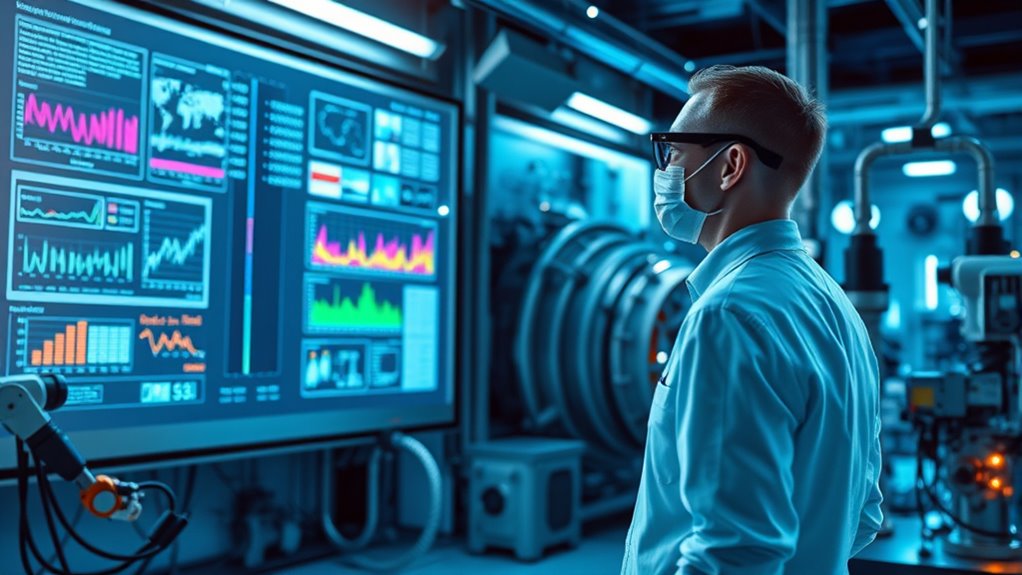Predictive maintenance uses AI and sensor data to monitor your machinery constantly. It detects signs of wear and potential failures early, often before you notice any issues. By analyzing real-time information like temperature, vibration, and pressure, AI learns your equipment’s patterns and predicts problems with high accuracy. This helps you schedule repairs more effectively and avoid costly breakdowns. Keep exploring to discover how this technology is transforming industrial operations and boosting reliability.
Key Takeaways
- AI analyzes sensor data to detect early signs of machinery wear, often identifying issues before human operators notice.
- Machine learning models predict failures accurately, enabling proactive maintenance and reducing unexpected breakdowns.
- Continuous monitoring allows AI to understand operational patterns, optimizing maintenance schedules beyond human capabilities.
- Data-driven insights help industries extend equipment lifespan and improve overall operational efficiency.
- Integrating AI with sensors converts machinery into intelligent systems that “know” their health better than manual inspections.

Have you ever wondered how industries prevent unexpected equipment failures and save costs? The answer lies in predictive maintenance, a proactive approach that uses advanced technology to monitor machinery health continuously. At the heart of this system is sensor integration, which involves installing various sensors on equipment to collect real-time data on temperature, vibration, pressure, and other critical parameters. These sensors act as the nerves of your machinery, providing a constant stream of information that, when analyzed properly, can reveal early signs of wear and tear before problems escalate.
Predictive maintenance relies on sensor integration to detect early signs of equipment wear before failures occur.
Once the sensors gather data, data analytics come into play. Instead of manually inspecting machines, you rely on intelligent algorithms to process the vast amounts of information collected. These analytics can identify patterns, detect anomalies, and predict potential failures with remarkable accuracy. By applying machine learning models to sensor data, you gain insights that were previously impossible to see with traditional maintenance methods. This means you can schedule repairs only when necessary, avoiding unnecessary downtime and extending the lifespan of your equipment.
Implementing sensor integration and data analytics allows you to shift from reactive maintenance—fixing machines after they break—to predictive maintenance, which anticipates issues before they happen. This shift not only minimizes costly breakdowns but also optimizes your maintenance schedules, saving you time and resources. For example, if vibration sensors detect unusual activity in a motor, the system can alert you early enough to perform a targeted inspection or repair, preventing a complete failure. This proactive approach keeps your operations running smoothly and reduces unplanned outages.
Furthermore, the insights gained from sensor data analytics help you understand your equipment better than ever before. You can identify patterns related to specific operational conditions, enabling you to fine-tune your maintenance strategies. Over time, this leads to more efficient use of resources and improved overall reliability. The integration of sensors with advanced analytics tools also facilitates remote monitoring, so you can oversee multiple plants or facilities from a single dashboard, reducing the need for on-site inspections.
In essence, sensor integration and data analytics turn your machinery into intelligent systems that actively inform your maintenance decisions. This technological synergy empowers you to act swiftly, prevent failures, and considerably cut costs. As industries continue to adopt predictive maintenance, you’re positioned to enjoy more uptime, longer equipment life, and smarter resource management—all driven by AI’s ability to understand your machines better than you ever could manually. Additionally, leveraging vetted products ensures that the sensors and analytics tools used are safe and effective, maximizing your investment in predictive maintenance.
Frequently Asked Questions
How Accurate Are AI Predictions in Different Industries?
AI predictions vary across industries, but with proper sensor integration and advanced predictive analytics, they become quite accurate. You can rely on AI to forecast equipment failures or operational issues early, helping you prevent downtime and reduce costs. While accuracy depends on data quality and industry specifics, continuous improvements in sensor tech and analytics algorithms are making AI predictions increasingly reliable across manufacturing, healthcare, and energy sectors.
What Are the Initial Costs of Implementing Predictive Maintenance?
You might think implementing predictive maintenance is costly, but a thorough cost analysis shows it can save money long-term. Initial expenses include acquiring sensors, software, and training staff, which require careful budget planning. While upfront costs can be significant, they often offset unexpected breakdowns and maintenance delays. By understanding these costs early, you can make smarter decisions and ensure a smoother integration process, ultimately boosting your equipment’s reliability.
How Does AI Handle False Positives and Negatives?
You might wonder how AI manages false positives and negatives. It handles this through sensor calibration, ensuring data accuracy, and false alarm mitigation strategies, which reduce unnecessary alerts. By continuously refining models with real-time data, AI improves its predictions, minimizing errors. This way, you gain more reliable insights, preventing unnecessary maintenance and downtime, and keeping your operations smooth and efficient without being overwhelmed by false alarms.
What Skills Are Needed for Maintenance Teams to Utilize AI Tools?
You need to develop skills in machine learning and data integration to effectively use AI tools. Understanding how AI interprets sensor data helps you make better decisions. You should also be able to interpret AI insights and troubleshoot issues. Gaining experience with data analysis and collaborating with data scientists will ensure your maintenance team can leverage AI’s full potential, improving maintenance accuracy and reducing downtime.
How Is Data Privacy Maintained in Ai-Powered Systems?
You guarantee data privacy in AI-powered systems by using data encryption, which protects sensitive information during storage and transmission. Additionally, you obtain user consent before collecting or processing data, respecting individual privacy rights. Regular audits and secure access controls help prevent unauthorized use. By combining these measures, you safeguard data while enabling AI to enhance system performance, maintaining trust and compliance with privacy regulations.
Conclusion
As you embrace predictive maintenance, you’ll find AI becomes an almost omniscient guardian for your machines, catching issues before they even arise. It’s like having a crystal ball that foresees every malfunction, saving you from disaster. With AI’s relentless vigilance, your equipment stays healthier than ever—almost as if it knows your machinery better than you do. This technology isn’t just a tool; it’s the future’s most powerful partner, transforming how you maintain and manage your assets.









